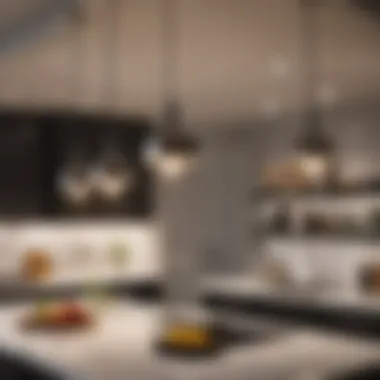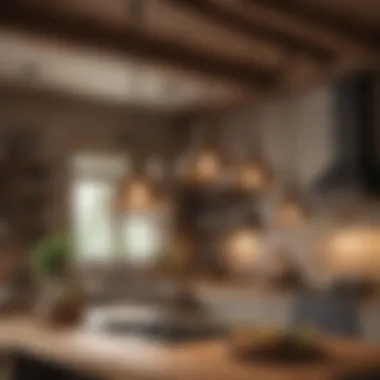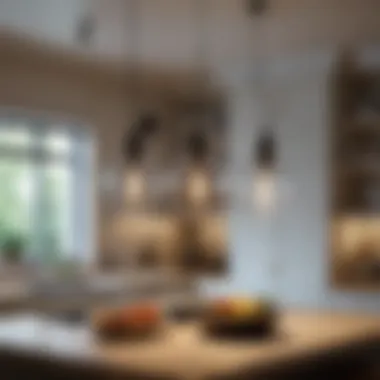Elegant Pendant Lighting Ideas for Kitchen Islands


Intro
Selecting the right pendant lighting for a kitchen island is crucial for both aesthetic appeal and practical functionality. Kitchen islands often serve as the central hub of culinary activity and relaxation in many homes. Thus, the type of lighting chosen can significantly influence the atmosphere and utility of this space.
This article aims to illuminate the different pendant lighting options available while addressing key considerations for homeowners and design enthusiasts alike. From trending styles to effective installation methods, we will delve into various aspects of pendant lighting that optimize not just light, but also the overall kitchen environment.
Design Inspiration
Trending Styles
When it comes to pendant lighting, current trends lean towards a mix of modern and vintage influences that cater to various tastes. Popular styles include:
- Industrial: Characterized by exposed bulbs and metals, this style adds a rugged yet elegant touch.
- Minimalist: Simple lines and shapes create a clean look, allowing other kitchen elements to stand out.
- Vintage: Retro designs often feature ornate glass or metal components that add character and charm.
- Glass: Clear or frosted glass fixtures allow light to disperse beautifully while providing a touch of sophistication.
Incorporating these styles can enhance your kitchen island without overwhelming the existing decor. It’s essential to consider how these styles align with the overall theme of your kitchen.
Color Palettes
Color plays a significant role in the selection of pendant lights. The colors chosen can either complement or contrast the kitchen space. Here are some factors to keep in mind:
- Neutral Tones: White, black, and gray fixtures can fit into almost any kitchen style, offering versatility.
- Bold Colors: Bright hues such as emerald green or deep navy can serve as statement pieces, drawing the eye and creating focal points.
- Metallic Finishes: Gold, brass, or copper can warm up the space and elevate the overall aesthetic.
The right color can breathe life into a kitchen. Thus, assessing existing tones in your kitchen is critical in making informed choices.
Practical Tips
Maintenance & Care
Proper care for pendant lights ensures longevity and optimal performance. Here are a few maintenance tips:
- Regular Cleaning: Dust and grime can tarnish aesthetics. Regularly wipe down fixtures with a soft cloth.
- Bulb Replacement: Check bulbs routinely. Dimming or flickering lights may indicate it's time for a replacement.
- Safe Installation: Ensure that the lights are securely installed to prevent any accidents.
Budgeting & Planning
Budgeting is an essential part of any home improvement project. The costs can range based on design and material choices. Consider the following:
- Value Range: Setting a budget range based on light quality, design, and size can help narrow down options.
- Installation Costs: Whether you hire a professional or do it yourself, factor in installation costs when budgeting.
"Choosing the right pendant light is about finding balance between functionality and design."
By keeping these tips in mind, you can navigate both the financial and practical aspects of selecting pendant lighting with ease.
Understanding Pendant Lighting
Pendant lighting is more than just a trend in interior design; it serves a significant purpose in enhancing the overall ambiance of a space, particularly kitchen islands. This section will delve into the fundamental aspects that define pendant lighting and its relevance in modern kitchens. Understanding pendant lighting is crucial for homeowners aiming to achieve a perfect balance between aesthetic appeal and functionality in their culinary spaces.
The importance of pendant lighting lies in its versatility. It can set the mood while providing necessary illumination for various tasks, from meal preparation to social gatherings. Additionally, pendant lights can effortlessly elevate the design of a kitchen, becoming a focal point that complements surrounding decor. Choosing the right pendant light can help in highlighting the unique characteristics of a kitchen island which could be a centerpiece for gatherings.
When considering pendant lighting, it is essential to evaluate several elements. The size and placement of lights can impact the space significantly. Understanding the functional and aesthetic aspects can help homeowners make informed choices, ensuring that the selected lights add value both in illumination and style.
Definition and Purpose
Pendant lighting refers to light fixtures that hang from the ceiling by a rod, cord, or chain. They are typically found in clusters or as singular units, suspended above countertops, kitchen islands, or tables. The main purpose of pendant lights is to provide focused lighting in specific areas while also contributing to the overall design aesthetic of the room. This targeted illumination is crucial in kitchens where a functional workspace is essential.
The versatility of pendant lights cannot be overstated. They come in various styles, materials, and sizes, allowing homeowners to select options that resonate with their interior design preferences. The purpose extends beyond mere illumination; it is about creating a space where functionality and beauty coexist seamlessly.


History of Pendant Lighting
The history of pendant lighting can be traced back to ancient times, where primitive forms of hanging light sources were used for basic illumination. Over time, these rudimentary fixtures evolved, with significant advancements in technology, materials, and design. In the early 20th century, pendant lighting gained popularity in public spaces such as restaurants and hotels, epitomizing elegance and sophistication.
By the 1920s and 1930s, pendant lights became more accessible for residential use. Art Deco and Mid-Century Modern movements introduced innovative designs, integrating artistic elements with functional lighting. The post-war era saw a boom in home ownership, leading to a surge in pendant lighting applications in kitchens. Today, pendant lights are a staple in contemporary homes, adapting styles and functionalities to meet the diverse needs of homeowners.
Understanding the evolution and purpose of pendant lighting offers invaluable context for homeowners and design enthusiasts. There is a rich tapestry of history layered within these fixtures, creating fascinating intersections between practicality and style.
Types of Pendant Lights
Understanding the various types of pendant lights can significantly influence the overall design and functionality of a kitchen island. Selecting the right type is not just about aesthetics; it involves considering how the lighting will interact with the space, the purpose it serves, and how it can enhance the kitchen's atmosphere. This section delves into three primary styles of pendant lighting: single pendant lights, multi-pendant arrangements, and adjustable pendant lights. Each type brings unique benefits and considerations that can match diverse preferences and practical needs.
Single Pendant Lights
Single pendant lights are a popular choice for kitchen islands, especially when the aim is to provide focused illumination over a specific area. Their simplicity makes them versatile, suitable for various design styles from modern to rustic. When chosen wisely, a single pendant can serve as a standout piece, enhancing the visual appeal of the space while providing adequate lighting.
Considerations for using single pendant lights include their height, which should be adjusted according to the size of the island. Generally, they should hang 28 to 34 inches above the countertop. This height ensures effective light distribution without obstructing views. The selection of materials is also crucial. Metal, glass, and fabric can each create a different ambiance and must complement the kitchen's overall design.
Multi-Pendant Arrangements
Multi-pendant arrangements offer a more dynamic approach to lighting in a kitchen. By using several pendants, homeowners can create layers of light that add depth and interest. This option is ideal for larger islands or when a more expansive workspace requires even illumination.
When planning a multi-pendant setup, it’s essential to consider the spacing between the pendants. A general guideline is to space them about 24 to 30 inches apart. Additionally, the height should remain consistent across all pendants to create a cohesive look. Variety in the size, shape, or color of the pendants can also be leveraged to inject personality into the design. However, maintaining a theme ensures harmony within the space.
Adjustable Pendant Lights
Adjustable pendant lights are particularly advantageous in kitchens where the lighting needs may change depending on the activities taking place. They provide flexibility to modify the height and direction of the light source, making them suitable for tasks such as cooking or gathering. Adjustability allows homeowners to tailor the lighting experience according to specific needs or preferences.
When choosing adjustable pendant lights, consider the mechanism of adjustment. Some pendants feature a simple cord system, while others may have more complex track systems. These should be installed following safety guidelines, ensuring stability when height adjustments are made. Besides functionality, the style of the adjustable pendant should align with the kitchen's decor to maintain visual coherence.
Key Takeaway: The choice between single pendant lights, multi-pendant arrangements, and adjustable pendant lights can greatly affect not only the aesthetics of the kitchen island but also its functionality. Each type offers unique benefits, and careful consideration can lead to a well-designed and practical lighting solution.
Design Considerations
When selecting pendant lighting for kitchen islands, design considerations play a critical role. These considerations guide the overall look and functionality of the kitchen space. Understanding how various elements interconnect can enhance both aesthetic appeal and practical use of the illumination.
Size and Scale Appropriateness
The size of pendant lights must correspond with the dimensions of the kitchen island. It is essential to measure the island's width and height. If the island is large, many small pendants may be too scattered, while a single large fixture might overwhelm the area. A good rule of thumb is to choose pendants that are about one-third the height of the island. This proportion ensures a balanced look.
Another factor to consider is the number of pendants used. For wider islands, a cluster of three or more pendants can create a cohesive look. In contrast, a narrow island can benefit from a single, well-placed pendant. In this way, size and scale work closely together to create harmony in lighting.
Style Compatibility
When choosing pendant lights, aligning their style with the overall design of the kitchen is of utmost importance. The following styles often complement kitchen islands:
Modern
Modern pendant lights are known for their clean lines and minimalistic designs. A key characteristic is the use of materials like metal and glass, which bring a sleek and polished look. This style is popular due to its versatility; it can match various color schemes and kitchen types. Unique features include geometric shapes that can serve as standout pieces without being overwhelming. However, while modern designs can elevate aesthetic appeal, they may lack the warmth of more traditional options.
Industrial
Industrial pendant lights often incorporate raw materials such as exposed bulbs and metal finishes. This style adds a rugged charm to kitchens, appealing to those looking to create an urban vibe. The notable characteristic of industrial lighting is its utilitarian feel, making it a practical choice for working areas. Its unique feature lies in the combination of form and function, providing ample lighting without sacrificing style. The downside might be that it does not fit well within more traditional, cozy kitchen settings.


Rustic
Rustic pendant lights emphasize natural materials like wood and wrought iron. A key characteristic is the emphasis on artisanal craftsmanship. This style is beneficial for those wanting a homey, inviting atmosphere in the kitchen. Rustic fixtures often bring warmth and a sense of timelessness. However, while they enhance a traditional kitchen's charm, they may not integrate as seamlessly into contemporary designs.
Classic
Classic pendant lights offer a sense of elegance and sophistication. They typically feature intricate details and rich finishes. Their key characteristic is the ability to enhance a traditional kitchen's grace while being adaptable enough for modern spaces. A unique feature includes the variety of shapes, from chandeliers to lantern designs. The downside is that classic options may require more maintenance due to their detailing.
Color and Finish Selection
Color and finish play a significant role in selecting pendant lighting. It's essential to choose colors that complement the kitchen's color palette. For instance, brushed nickel can fit well in modern designs, while oil-rubbed bronze suits more traditional settings. Besides, finishes can affect the overall mood of the space. Matte finishes often provide a subtler look, whereas glossy finishes can add brilliance and shine. Thus, careful selection of colors and finishes can enhance the kitchen island's aesthetic and functional characteristics.
"The pendant lights over your kitchen island should not only illuminate but also enhance the visual appeal of the space."
Understanding these design considerations allows for a more informed choice of pendant lighting, ensuring a harmonious blend of style and function.
Functionality and Illumination
In any kitchen setting, the balance between functionality and aesthetics is key. Pendant lighting plays a critical role in this equilibrium. When considering pendant lights for your kitchen island, it is essential to prioritize the practical aspects of illumination alongside their design. Light not only enhances visibility but also contributes to the overall atmosphere of the kitchen.
Selecting a pendant light requires understanding how various lighting options impact your daily tasks. For instance, proper illumination is vital during cooking or food preparation. Therefore, functionality encompassess the intensity, direction, and quality of light emitted from the fixtures.
Lumen Output Considerations
Lumen output indicates how much light a fixture produces. A high lumen output means brighter light. This is especially important for a kitchen island, which is often the focal point for food preparation and socializing. When choosing pendant lighting, consider the size of your kitchen and the height of the island. A larger island may require multiple pendant lights with higher lumen outputs to ensure adequate illumination.
Key Tips:
- Ideal lumen levels for task lighting usually range between 300 to 800 lumens per fixture.
- Consider the overall ambient light in your kitchen. If your space is naturally bright, you may be able to select fixtures with lower lumen output.
Light Bulb Types and Their Effects
LED
LEDs have become a preferred choice for many homeowners. Their energy efficiency is the primary appeal, as they consume significantly less power compared to other types. The long lifespan of LED bulbs makes them a cost-effective option in the long term. They also provide instant brightness and come in various color temperatures, allowing you to create the desired atmosphere. However, the initial cost can be higher than traditional bulbs.
Incandescent
Incandescent bulbs offer a warm, inviting light that many find attractive. Their ability to render colors accurately makes them a popular choice for kitchens. The warmth creates a comfortable atmosphere, especially during evening gatherings. However, they are less energy-efficient and have a shorter lifespan compared to LEDs. They may not be the best choice for areas where long-term savings on electricity are a goal.
CFL
Compact fluorescent lamps, or CFLs, are another option that provides a balance between incandescent and LED bulbs. They consume less power than incandescents while providing good light quality. They have a longer lifespan than incandescent bulbs, making them a practical choice. However, some homeowners find that CFLs can take time to reach full brightness, which can be an inconvenience.
Dimming Features
Dimming capabilities can greatly enhance the versatility of pendant lighting in your kitchen. A dimmer switch allows you to adjust the light level according to your needs. This is particularly useful during different times of the day when light requirements change. By providing softer lighting during evening hours, you can create a cozier atmosphere for dining or entertaining.
Consideration of dimming features means looking for compatible bulb types. Not every bulb works with dimmer switches, so checking specifications before purchase is crucial. Incorporating this functionality can elevate both the utility and ambience of your kitchen space.
Installation Guidelines
When it comes to pendant lighting in kitchen islands, the installation guidelines are crucial for achieving both aesthetic and functional goals. Proper installation ensures optimal lighting distribution, enhances the design, and adds to the overall usability of the kitchen space. By considering various elements such as height, electrical considerations, and the choice between professional versus DIY installation, homeowners can create an inviting and practical environment.


Height and Placement Recommendations
Choosing the correct height for pendant lighting above a kitchen island is vital. Ideally, pendants should hang between 30 and 36 inches above the surface of the island. This range allows adequate illumination without obstructing sight lines. It is important to take into account the size of the island and the scale of the fixtures chosen.
For larger islands, consider using multiple pendants spaced evenly. For instance:
- Space pendants about 30 inches apart, ensuring they collectively illuminate the workspace.
- Use larger fixtures for wider islands, placing them slightly lower for dramatic effect.
In addition, consider the ceiling height. A standard 8-foot ceiling allows for standard height, while taller ceilings may necessitate adjustments. Proper placement not only ensures functionality but also maintains visual appeal.
Electrical Considerations
Proper electrical installation is a critical aspect often overlooked in pendant lighting setup. Before installing, ensure that your electrical system can support the additional load. Consult a professional electrician to assess:
- Wattage capacity of existing circuits to avoid overloads.
- Wiring types needed based on the chosen pendant light.
- Switch connections, whether dimmer switches are appropriate for compatible fixtures.
In older homes, antique wiring may require updates to meet current safety standards. Always prioritize safety in your electrical considerations to prevent hazards.
Professional Installation vs. DIY
Deciding between hiring a professional installer or attempting a DIY project can significantly affect the outcome of your pendant lighting. Each option has its own set of benefits:
- Professional Installation:
- DIY Installation:
- Ensures compliance with local electrical codes.
- Saves time and reduces the risk of faulty wiring.
- Can be more cost-effective and rewarding if you have experience with home projects.
- Allows for greater personalization in the installation process.
If opting for DIY, clear instructions and proper tools are essential. Conversely, when in doubt about knowledge or capabilities, relying on a professional installation can safeguard your investment in your kitchen's design and lighting. Always weigh the risks and benefits when making this decision.
Maintenance and Care
Evaluating pendant lighting for kitchen islands involves more than just the initial selection. Maintenance and care are essential for sustaining both aesthetic charm and functional efficiency of these lighting fixtures. Regular maintenance helps to ensure longevity and consistent performance, allowing homeowners to enjoy their investment for many years. The significance of proper care cannot be overlooked, as poor maintenance can lead to decreased illumination, malfunctioning parts, and an overall neglected appearance that detracts from the kitchen's design.
Cleaning Techniques
Keeping pendant lights clean is crucial. Dust and grease accumulate on surfaces over time, impairing the light output and tarnishing the overall look. Here are some effective cleaning techniques to consider:
- Regular Dusting: Use a soft, microfiber cloth to wipe down the light fixtures periodically. This helps to prevent dust build-up.
- Gentle Washing: For glass or crystal pendants, mix a mild dish soap with lukewarm water. Soak a cloth and wipe the surfaces gently to remove stubborn stains or grease.
- Avoiding Abrasives: Never use abrasive cleaners or rough sponges, as they can scratch finishes and damage the material.
- Checking for Maintenance Alerts: Some modern pendant fixtures come with indicators for when cleaning or maintenance is required. Be sure to follow these alerts to ensure the fixture remains in good condition.
Replacing Bulbs and Fixtures
Replacing bulbs and fixtures is a necessary task to keep pendant lighting effective. Over time, bulbs will burn out or may lose brightness. Here are some points to keep in mind for replacing bulbs and fixtures:
- Selecting the Right Bulb: Ensure you choose a bulb that matches the fixture's specifications. Consider the appropriate wattage and type, whether LED, incandescent, or CFL, as discussed earlier.
- Timing for Replacement: When you notice flickering lights or a significant drop in brightness, it may be time to consider replacing bulbs.
- Fixture Replacement Considerations: If a fixture has sustained damage or has become outdated, consider updating it to match current design trends or improve functionality. This can enhance the overall aesthetic of the kitchen.
- Safety First: Always turn off power at the circuit breaker before attempting to replace bulbs or fixtures. This ensures safety and reduces the risk of electrical accidents.
By adhering to these maintenance and care guidelines, homeowners can enjoy their pendant lighting not only as a functional element but also as a lasting aspect of their kitchen decor.
Ending
Pendant lighting plays a critical roles in defining the aesthetic and functionality of kitchen islands. Selecting the right lighting can enhance visual appeal, illuminate workspaces, and create ambiance. The careful consideration of various factors — style, scale, lumen output, and installation — is essential in this process. By understanding the crucial elements discussed throughout this article, homeowners can make informed decisions that result in a harmonious kitchen environment.
Recap of Key Choices
In choosing optimal pendant lighting for kitchen islands, several key factors come into play:
- Types of Pendants: Single pendants provide focused light while multi-pendant arrangements can add drama and complexity. Adjustable options allow for versatility in light distribution.
- Design Compatibility: Ensure that the chosen pendant lighting matches the overall decor style of the kitchen. Options like industrial, modern, rustic, and classic each offer unique aesthetics.
- Functional Requirements: Consider the lumen output required for the intended tasks in the kitchen. This ensures adequate lighting for cooking and preparation.
- Installation Guidelines: Height and placement are essential in determining how light is received in the space. Professional installation may also be necessary for optimal results.
Final Thoughts on Pendant Lighting
Choosing the appropriate pendant lighting is not merely about aesthetics. It is also fundamentally about creating an environment that is both functional and inviting. The integration of light into kitchen design significantly influences how the space is used and appreciated. As trends evolve, the diversity in styles and technologies available makes it an exciting time for homeowners and designers alike. By investing attention into the pendant lighting choices for kitchen islands, one can greatly enhance not just the look but also the experience of the kitchen, which often serves as the heart of the home.















